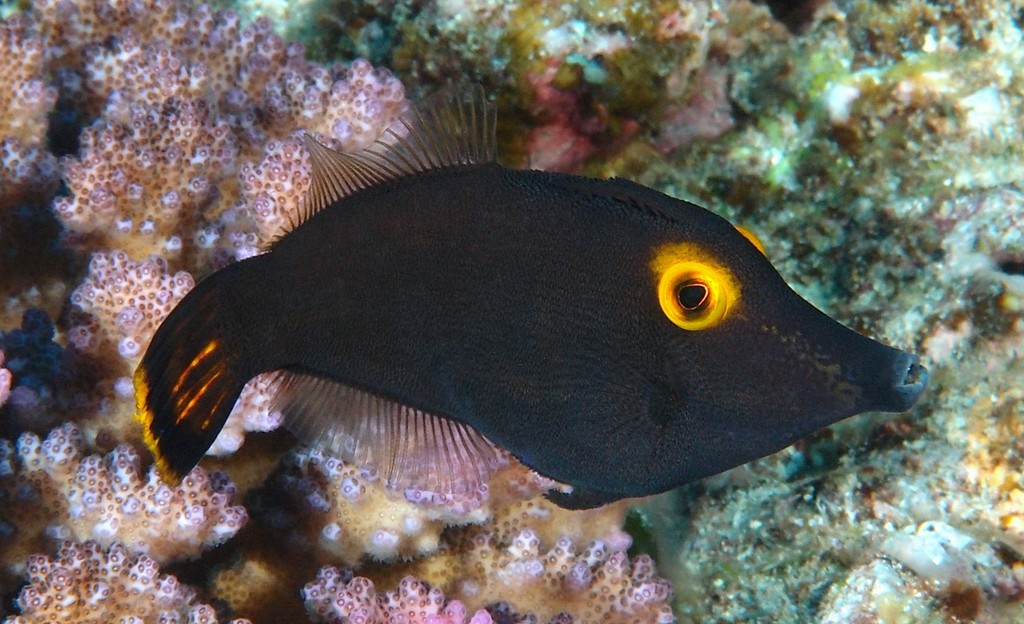PERVAGOR ALTERNANS - (OGILBY, 1899)
Actinopterygii (Gigaclass) > Actinopteri (Class) > Teleostei (Subclass) > Tetraodontiformes (Order) > Balistoidei (Suborder) > Monacanthidae (Family) > Pervagor (Genus)
Poisson-lime à oeil jaune, Yelloweye filefish, Yelloweye Leatherjacket, Bright-eye Filefish, Yellow-eyed Leatherjacket,
Synonymes
Monacanthus alternans (Ogilby, 1899)
Pervagor melanocephalus marshallensis (Woods, 1966)
------------------------------------
Description
Dorsal spines (total): 2; Dorsal soft rays (total): 31-34; Anal soft rays: 27-31; Pectoral fin rays: 12-13 (usually: 13); Vertebrae: 19. Snout pointed, its dorsal profile concave; Caudal peduncle short and deep; A strong first dorsal spine armed with two rows of prominent, laterally-directed barbs. Posterior margin of ventral flap not attached to large and barbed pelvic rudiment. Scales on posterior half of body with spinules, number increasing with age; Adult male with scale rugosities. Max. length: 16.0 cm TL. Depth range: 15 - 50 m.
Color
Distinguished by a bright yellow ring around the eye. Head and body blackish brown to pale, pinkish brown; Blackish band usually encircling the snout; Eyes and surrounding area bright yellow. Caudal fin generally orange; Soft dorsal and anal fins spotted, clear or yellowish orange basally; Pectoral fins clear, base blackish brown.
Etymology
Pervagor: from Latin, pervagor = I wander through, I rove about, nomadic, itinerant.
alternans: from Latin, alternans = alternating, vacillating. In referrence to body color pattern.
Original description: Monacanthus alternans Ogilby, 1899 - Type locality: Maroubra Beach, New South Wales, Australia.
Distribution
Western Pacific: Australia, Lord Howe Island, New Caledonia and Marshall Islands.
Biology
Uncommon species that occurs in coral and rocky reefs.
Poisson-lime à oeil jaune, Yelloweye filefish, Yelloweye Leatherjacket, Bright-eye Filefish, Yellow-eyed Leatherjacket,
Synonymes
Monacanthus alternans (Ogilby, 1899)
Pervagor melanocephalus marshallensis (Woods, 1966)
------------------------------------
Description
Dorsal spines (total): 2; Dorsal soft rays (total): 31-34; Anal soft rays: 27-31; Pectoral fin rays: 12-13 (usually: 13); Vertebrae: 19. Snout pointed, its dorsal profile concave; Caudal peduncle short and deep; A strong first dorsal spine armed with two rows of prominent, laterally-directed barbs. Posterior margin of ventral flap not attached to large and barbed pelvic rudiment. Scales on posterior half of body with spinules, number increasing with age; Adult male with scale rugosities. Max. length: 16.0 cm TL. Depth range: 15 - 50 m.
Color
Distinguished by a bright yellow ring around the eye. Head and body blackish brown to pale, pinkish brown; Blackish band usually encircling the snout; Eyes and surrounding area bright yellow. Caudal fin generally orange; Soft dorsal and anal fins spotted, clear or yellowish orange basally; Pectoral fins clear, base blackish brown.
Etymology
Pervagor: from Latin, pervagor = I wander through, I rove about, nomadic, itinerant.
alternans: from Latin, alternans = alternating, vacillating. In referrence to body color pattern.
Original description: Monacanthus alternans Ogilby, 1899 - Type locality: Maroubra Beach, New South Wales, Australia.
Distribution
Western Pacific: Australia, Lord Howe Island, New Caledonia and Marshall Islands.
Biology
Uncommon species that occurs in coral and rocky reefs.
